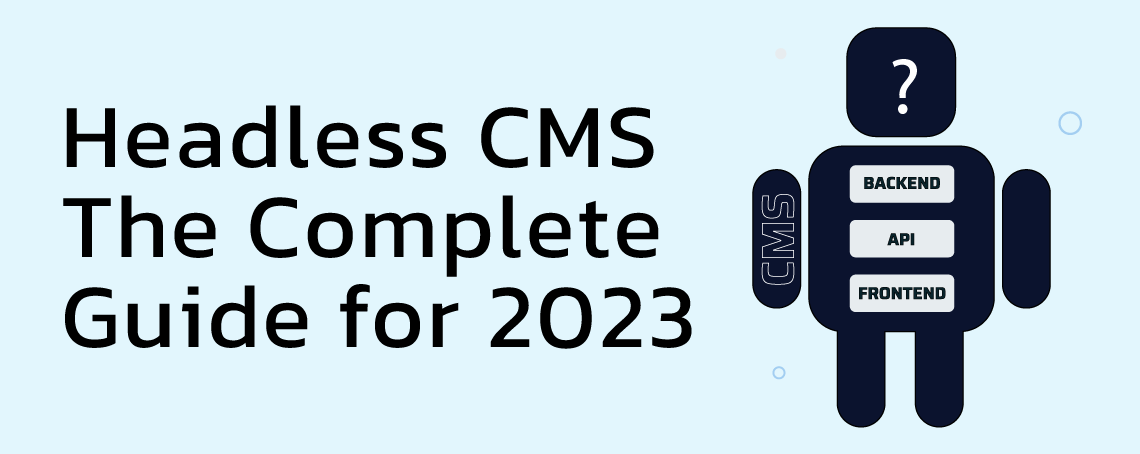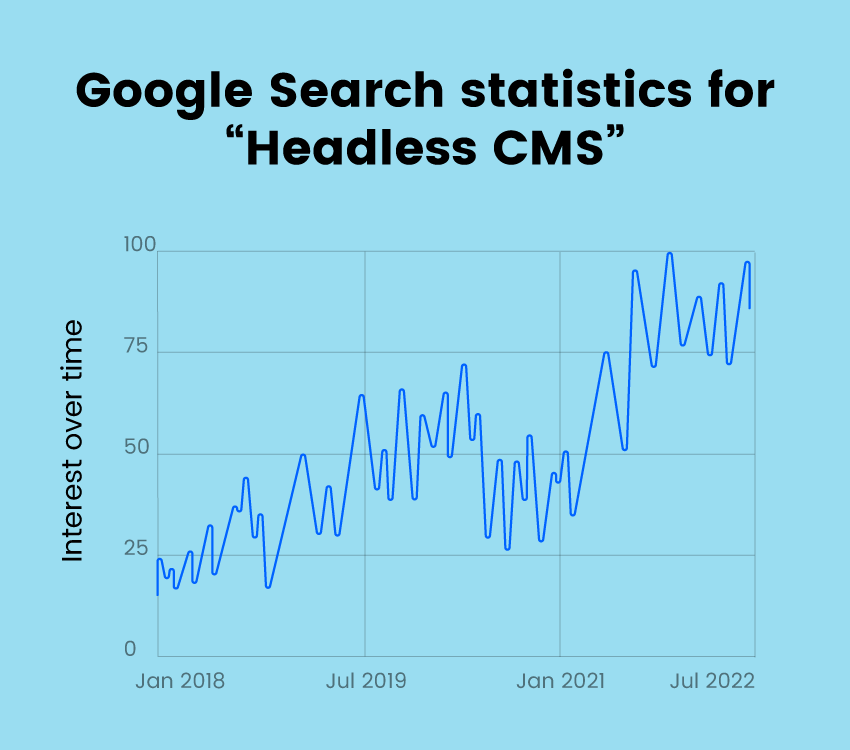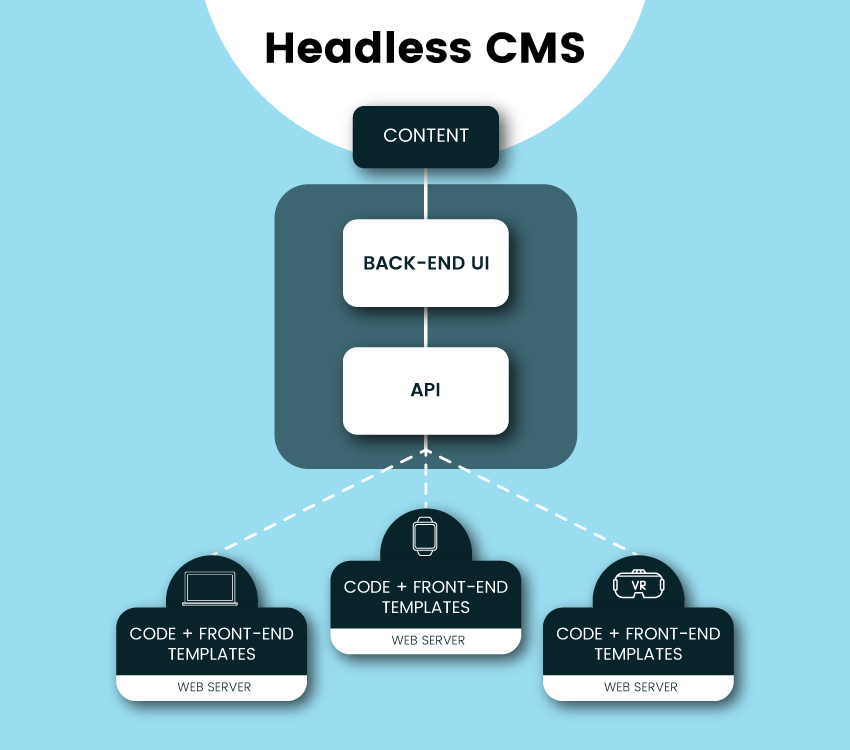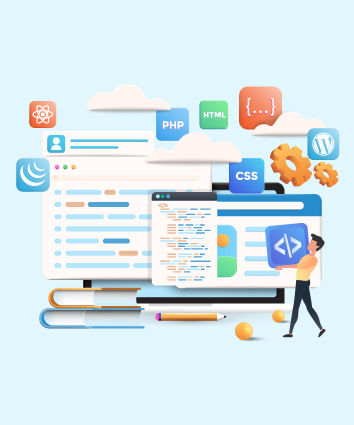The Beginner’s Guide to Headless CMS

The popularity of headless content management systems has skyrocketed lately, and more and more companies are adopting this model to distribute information to their customers. Increased interest in “headless CMS” in Google search statistics is more evidence of this trend. So, in this article, let’s dive into the topic of “What is Headless CMS?” here. Moreover, we will see the Headless CMS Vs Traditional CMS comparison too.

Businesses can’t use their website as their only content distribution method anymore. Smartphones and tablets are becoming ubiquitous in consumers’ lives, and they’re often used on the move. Some people even have smart appliances, such as digital assistants, speakers, and sound systems, installed in every room of their house, beginning with the refrigerator.
Many companies are turning to headless architecture to meet their customers’ demands. Future Market Insights projects that the market for headless CMS will expand from its current $752 million in 2022 to a whopping $5.528 billion by 2032.
However, what is Headless CMS? Exactly how does it function, and what are its advantages?
Our comprehensive guide will answer all of your questions and give a side-by-side comparison between Headless CMS Vs Traditional CMS.
What is Headless CMS?
To distinguish the content repository from the display layer, several CMSs have adopted the “headless” architecture.
Instead, application programming interfaces (APIs) link the two levels, supplying information to a website and several additional digital channels, such as the increasingly popular smart gadgets.
The front and back end may be independent, providing more flexibility for content teams and engineers. They are no longer constrained in both their content creation and distribution options. Headless content management systems (CMSs) are popular among developers because they provide them with more leeway when designing frontend user interfaces and content experiences.
They have access to cutting-edge tools and the most widely used JavaScript frameworks, resulting in enhanced speed and functionality.
A headless content management system (CMS) gives businesses the mobility, adaptability, and scalability they need to stay ahead of the competition as technology and business demands evolve.
How Does a Headless CMS Work?
A conventional content management system (CMS) will help us grasp how a headless system functions.
In a classic CMS, there is a tight coupling between the display layer at the front and the content repository at the back. One channel, like a website, receives content that has been pre-populated into a template.
Traditional content management systems (CMSs) are fantastic for blogs but cumbersome when posting information to other channels, such as WordPress.
Using application programming interfaces (APIs), a headless content management system (CMS) may efficiently transfer information between the server and the client.
Backend content administration is done the same way as in a conventional CMS. Still, there is no specific template into which material must be inserted.
Instead, developers may build frontend interfaces from scratch using a variety of frameworks and technologies, making information accessible in various ways.
Headless CMS vs Traditional CMS
This comparison between Headless CMS Vs Traditional CMS should clear up any remaining questions. If you use this guide, picking a suitable Headless CMS for your company will be much easier.
| Headless CMS | Traditional (Coupled) CMS |
| The front- and backends of a headless CMS are separated. | Typical CMS systems are monolithic. |
| It is highly secure. | Comparatively less secure. |
| It is flexible. | It is rigid. |
| To establish and sustain, development resources and qualified staff are required. | Requires a small staff for installation and maintenance. |
| It’s appropriate for websites, apps, and other devices. | It is appropriate exclusively for websites. |
| With Headless CMS, it is simple to get the excellent performance of a website. | In conventional CMS, optimization is required for optimal website performance. |
| Setup and upkeep need development resources and a professional crew. | Requires a small staff for installation and maintenance. |
| It has frontend flexibility. | It is template-driven and lacks frontend flexibility. |
| The latest frameworks, resources, and technologies of the highest quality may be used. | Exclusively customized frameworks and templating engines may be used. |
| Model for serverless function expansion. | Plugin extension model. |
| Its architecture comprises mainly a backend and an API. | Its architecture comprises mainly the backend and the front end. |
| Fully and extensively scalable. | Scalability is just linear. |
| Provide total control over where and how your material is disseminated. | Traditional CMS does not give total control. |
| It has no design limitations. | There might be design restrictions. |
| You may personalize the experience for users and administrators. | It has a predetermined user and administrator experience. |
| It is futuristic and fashionable. | The trend is migrating away from conventional CMS and toward Headless CMS. |
Why Use a Headless CMS?
As a compelling metaphor, headless CMS may be seen as a system that divides the writing and publishing processes. Unlike front-end publishing, backend authoring is handled independently.
Our generation is about to enter a new age of interactive experiences that go well beyond the limitations of screens. Start planning for scenarios beyond multiple displays; users will get material in ways we haven’t imagined.
Simultaneously, consumers will start playing a much more significant role, engaging with material in novel ways and offering content providers more input.
For this reason, in the not-too-distant future, many businesses will need something beyond a conventional content management system. Investing in cutting-edge technology today will be fruitful in avoiding crises at a later stage.
Let’s look at headless CMS’s advantages to get you started.
It is Framework Agnostic
When using a headless CMS, frontend developers may leverage React and React-based frameworks such as Remix or Next.js. They are also free to use Angularjs and other technologies that best suit their skill set or the project.
It is Highly Secure
Security is another area where headless architecture excels. Cyberattacks, among others, are a common danger for legacy CMSs. Because of its decoupled design, a headless CMS makes it harder for these attackers to access sensitive data.
You can speed up the rollout of new web apps
Developers may focus on the front end without interfering with the work of marketers, who can focus on the back end. Consequently, both marketers and developers may speed up the rollout of new web apps, reducing the company’s time to market.
You can have Content Delivery to Multiple Platforms
One of the biggest draws of a headless CMS is its flexibility in terms of content distribution. Because of this, companies can provide customers with a consistent, high-quality omnichannel experience regardless of their channel to interact with them (website, social media platform, mobile device, in-store digital kiosk, etc.).
It works on Cloud
Most headless content management systems are also cloud-based platforms that can function with no on-premises hosting at all. As an alternative, they use cloud computing’s many features, such as its scalability, flexibility, ease of use, and accessibility.
You can Scale with it
Another perk of a headless CMS is its capacity to scale since its detached design makes it less challenging to handle traffic surges without sacrificing performance. Given that many modern platforms are hosted in the Cloud, businesses who want to expand their operations may do so with little investment in new on-premise servers.
You can integrate additional applications
It is possible to integrate additional applications into the technological stack by using the APIs that link the backend of the headless CMS to the frontend interface. The headless CMS integrates e-commerce, analytics, CRM, and customer data systems seamlessly.
Disadvantages of Headless CMS
Even though headless CMS is where the market is headed, it’s not without drawbacks.
It saves data without any presentation formatting or presentation
A headless content management system (CMS) saves data without any presentation formatting or presentation formatting to aid in reading, previewing, or updating material for marketing departments. Developers are responsible for any changes made to the design.
It uses a Fragmented Tech Stack
The use of microservices and the development of lightweight frontends for each supported channel or platform might result in a disjointed technology stack, making it difficult to understand how everything fits together or to keep it up to date.
Headless content management systems are still in their infancy. However, there have been numerous developments toward standardizing best practices and developing new microservices that restore the term “easy” to describe headless CMS.
It isn’t Marketing Friendly
A headless content management system (CMS) is primarily a backend tool to store material without any thought given to how that data will be seen. Design implementation must be left to developers, and no “user-friendly” tools are available to aid marketers. This neutral material also necessitates adding additional information, such as titles, alt text, or descriptions, as a stand-alone feature for search engine optimization.
Which Types of Businesses Benefit from a Headless CMS?
Any company that wants to provide a unique client experience would benefit significantly from a headless content management system. Adopting a headless CMS is beneficial for all companies, regardless of size or industry, but especially for those in the Financial Services sector and those with an e-commerce component to their digital offering.
Wrap-Up
There is a solid reason why the headless content management system has become so popular in the online world. It has a flexible front end and a future-proof technology stack that simplifies content creation. Still, moving to a headless content management system is significant.
Before converting to a headless CMS, there are many things to think about, such as the advantages and disadvantages of the system, as well as hosting and frameworks. If you’re new to headless CMS, we hope this blog will help.
Contact us anytime if you have more inquiries at hello@nflowtech.com.








